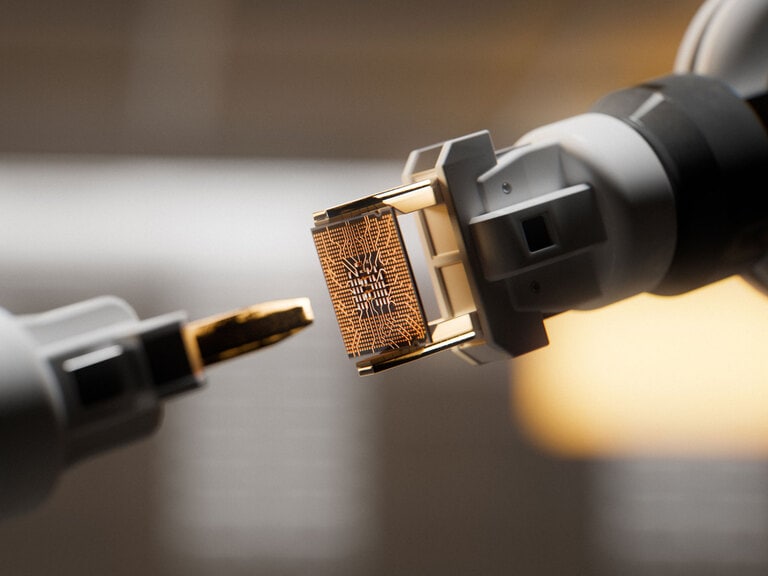AI has become the battleground for semiconductor supremacy — AMD, Intel, Nvidia and Qualcomm are all launching more efficient and more powerful chips. But because customers are often looking for a balance between cost and performance, those stocks with aggressive pricing strategies could win the race.
- Intel launches Lunar Lake, a next-generation mobile and laptop CPU that reportedly outperforms Qualcomm’s Snapdragon X Elite.
- AMD CEO Lisa Su believes the chip industry is in the early innings of a decade-long AI mega cycle.
- Nvidia announces the successor to its Blackwell chip architecture; Rubin will be available from the first half of 2026.
When Pat Gelsinger took to the stage at the COMPUTEX 2024 expo in Taipei, Taiwan, in early June, the Intel [INTC] boss took aim at Nvidia [NVDA] CEO Jensen Huang, and particularly his belief that Moore’s Law, a fundamental concept of semiconductors, is dead.
“Unlike what Jensen might have you believe, Moore’s Law is alive and well,” proclaimed Gelsinger during his keynote address (earlier this year, Huang had told Wired that “We have to leave Moore’s Law behind so we can think about new ways of scaling”).
The law was coined by Intel Co-Founder Gordon Moore in the 1960s; it argues that the number of transistors on a chip could double each year without the cost of production rising significantly.
Gelsinger said that Intel is currently looking “to have a billion transistors on a single chip and even looking to have a trillion transistors in a single package by the end of the decade”.
His keynote was also used to launch Lunar Lake, Intel’s next-generation mobile and laptop central processing unit (CPU). The successor to last year’s Meteor Lake CPU, Lunar Lake will be partly manufactured by Taiwan Semiconductor Manufacturing Co. [TSM] and is expected to launch in Q3 2024.
During the unveiling, Gelsinger refuted suggestions that rival Qualcomm’s [QCOM] Snapdragon X Elite was superior. “Lunar Lake, running in our labs today, outperforms the X Elite on the CPU, on the graphics processing unit and on artificial intelligence (AI) performance,” said Gelsinger. Lunar Lake will be equipped with 48 TOPS, a term used to measure AI processing power; the Snapdragon X Elite’s TOPS is 45.
Qualcomm Sees Sizeable Opportunity in AI PCs
Qualcomm unveiled the Snapdragon X Elite based on ARM [ARM] technology to much fanfare in May. The chip will power Microsoft’s [MSFT] next-generation laptops with built-in generative AI assistant Copilot+ — the new hardware is being shipped from mid-June.
Copilot+ PCs could help Qualcomm grow its revenue in the PC chip market as more consumers upgrade their devices. AI PCs have higher price tags, but it is a premium that consumers could be willing to pay if it means improved communication, creativity and productivity.
While the AI PC market is still in its infancy, Arm CEO Rene Haas told Reuters that the UK chip designer is targeting at least 50% of the Windows PC market within five years. When this was put to Qualcomm CEO Cristiano Amon by a Tom’s Hardware reporter, he indicated that this is definitely achievable.
“I like, for example, some of the things that some original equipment manufacturers (OEMs) said in their earnings calls … Some OEMs are talking about 40–60% of their total sales within three years … That’s kind of the opportunity that we have,” Amon said in a Q&A following his keynote.
AMD Launches Rival to Intel’s Lunar Lake
Not to be outdone in the AI PC race, AMD [AMD] unveiled two new PC CPUs at COMPUTEX which CEO Lisa Su claims will be able to handle AI better than any other PC CPU on the market. The Ryzen AI 300 Series will be able to deliver 50 TOPS, which would be better than both the Snapdragon X Elite and Lunar Lake.
The roll out of AI chips will not be slowing down anytime soon, either. “We’re really just at the beginning of a decade-long mega cycle for AI,” Su said in her keynote. Meeting the demand for AI products will require a faster roll-out of AI chips with the required specifications.
Nvidia Unveils Blackwell Successor to Ship in 2026
The blistering pace of AI chip development is perhaps best illustrated by Huang using his COMPUTEX keynote to reveal Rubin, Nvidia’s successor to its Blackwell chip architecture, which itself will only start shipping in the second half of 2024, while Rubin will be available from the first half of 2026.
Nvidia’s innovation comes at a steep price, however. Blackwell chips cost at least $30,000 and the Rubin chips are expected to cost significantly more. Intel’s Gelsinger believes that Intel’s aggressive pricing strategy will help it stay competitive with Nvidia — its Gaudi 3 GPU will cost around $15,000.
“Customers are looking for high-performance, cost-effective generative AI training … and they’ve started to turn to alternatives like Gaudi. They want choice,” Gelsinger said during his keynote.
Thematic Funds Offers Broad Exposure to the AI Chip Race
As chipmakers continue to ride the AI wave, one way to gain exposure to the semiconductor industry and AI race is through thematic ETFs.
The Themes Generative AI ETF [WISE] has Nvidia and AMD as its biggest and sixth-biggest holdings as of 11 June, with weightings of 9.1% and 4.8% respectively; Intel, meanwhile, has an allocation of 3.4% of the portfolio. The fund is up 9.7% since its launch on 8 December last year through 11 June.
The Global X AI & Technology ETF [AIQ] also has Nvidia as its biggest holding as of 10 June, with a weighting of 5.6%; Qualcomm is the third-biggest, with a weighting of 3.8% and Intel has been allocated 1.8%. As of 11 June the fund is up 10.7% year to date and 25.6% in the past year.
Continue reading for FREE
- Includes free newsletter updates, unsubscribe anytime. Privacy policy






